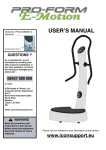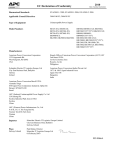Download APC BR650CI-AS Saw User Manual
Transcript
Back-UPS® 1 BR650CI / BR650CI-AS User Guide Connect Battery For safety, the Back-UPS is shipped with one battery wire disconnected. The Back-UPS will not operate until the wire is connected to the touch safe battery terminal. NOTE: Small sparks may occur during battery connection. This is normal. 2 1 TURN the Back-UPS over, and slide the battery compartment cover off of the battery housing. REMOVE the battery from the battery compartment, and connect the black wire to the negative (-) battery terminal. Ensure the battery is installed as shown below. 2 Connect Equipment Battery Backup Plug the Back-UPS power cord directly into a wall outlet, and not to a surge protector or power strip. The wall outlet should be located near the equipment, and easily accessible. These outlets are powered whenever the Back-UPS is switched ON. During a power outage, or other utility problems (brownouts, over-voltages), these outlets will be powered for a limited time by the Back-UPS. Plug your computer, monitor, and two other datasensitive devices (external disk or tape drive) into these outlets. Surge Protection Only Power Switch These outlets provide full-time protection from surges even if the Back-UPS is switched OFF. Plug your printer, fax machine, scanner, or other peripherals that do not need battery power into these outlets. Power On UPS Status Indicator (Green - OK, Red or AmberSee User Manual) Connect AC Line Cord Plug the Back-UPS power cord into a wall outlet, not a surge protector or power strip. The outlet should be near the equipment and easily accessible. 3 Press the ON/OFF switch to power the unit ON. A single short beep, and the green “Power On” indicator confirms that the Back-UPS is on and ready to provide protection. 4 The Back-UPS should charge for at least 24 hours to ensure sufficient runtime. The unit is being charged whenever it is connected to utility power, whether the unit is turned ON or OFF. Transfer Voltage and Sensitivity Adjustment (Optional) In situations where the Back-UPS, or connected equipment, appears too sensitive to the input voltage, it may be necessary to adjust the transfer voltage. This is a very simple task that requires the use of an ON/OFF push button. To adjust the transfer voltage, perform the following steps: 1. Plug the Back-UPS into the utility power source. The Back-UPS will be in “Standby mode” (no indicators are lit). 2. Press the ON/OFF push button fully in for 10 seconds. The Online LED will begin glowing in a cyclical order: GREEN-AMBER-RED, indicating it is going into “Program mode”. 3. The Back-UPS will then indicate the current sensitivity, as shown in the Transfer Voltage and Sensitivity Adjustment table below. 4. To select the LOW sensitivity setting, press the ON/OFF push button until the LED begins flashing GREEN. 5. To select the MEDIUM sensitivity setting, press the ON/OFF push button until the LED begins flashing RED. 6. To select the HIGH sensitivity setting, press the ON/OFF push button until the LED begins flashing AMBER. 7. To exit Programming mode, once sensitivity is set, wait approximately 5 seconds, and all of the LED indicators will be off (unlit). 990-2994B Copyright 2007 American Power Conversion Corp. INSTALL the battery compartment cover back onto the battery housing. Place the Back-UPS to avoid: - Direct sunlight - Excessive heat - Excessive humidity or contact with fluids Surge Protection Power On 3 Power On Status Indicators The Back-UPS ES indicates its operating status using a combination of visual and audible indicators. Use the following table to identify the status of the Back-UPS ES. Visual Indications (Power On - Green) (Replace Battery - Red) Audible Indication (Buzzer) GREEN On Off GREEN On (Off during 4 beeps) 4 beeps repeated every 30 seconds On-Battery - Back-UPS is supplying battery power to the load connected to the Battery outlets. Flashing GREEN Constant Beeping (every 1/2 second) Low Battery Warning - The Back-UPS is supplying battery power to the load connected to the battery outlets, and the battery has 1.5 minutes of battery power remaining. Alternating GREEN & RED Constant tone Bad Battery Detected - Battery needs to be charged, or is at end of life and must be replaced (see Replace Battery). Flashing RED Constant tone Battery Disconnected - The battery is disconnected or it is a bad battery (see Replace Battery). Off Short beep every 4 seconds Off Constant Tone On Battery Overload - Connected equipment requires more power than provided by Back-UPS battery. Unplug devices one at a time to remove overload. If not corrected contact APC Technical Support. GREEN On Constant Tone On Line Overload - The power drawn by the connected equipment exceeds the power capacity of the Battery Backup. Flashing RED Condition Power On - Back-UPS is supplying conditioned utility power to the connected equipment. Low Battery Shutdown - During On Battery operation the battery power was almost completely exhausted, and the Back-UPS is waiting for utility power to return to normal. Chirp every 2 seconds Charger Warning - Back-UPS has experienced an internal problem, but continues to power the load. Contact APC Technical Support. Off Constant Tone Charger Fault - Back-UPS has an internal problem, and is no longer powering the load. Contact APC Technical Support. Alternating GREEN/AMBER/RED Off Button Program Mode - see Section 4, and the table below. GREEN Flashing Off Low Sensitivity Mode - see Section 4, and the table below. RED Flashing Off Medium Sensitivity Mode - see Section 4, and the table below. AMBER Flashing Off High Sensitivity Mode - see Section 4, and the table below. Transfer Voltage and Sensitivity Adjustment Indicators Flashing Sensitivity Setting Input Voltage Range (For Utility Operation) Green Flashing LOW 155 - 290 Input voltage is extremely low or high. Not recommended for computer loads. Red Flashing MEDIUM (factory default) 160 -280 Back-UPS frequently goes on battery. Amber Flashing HIGH 165 - 270 Connected equipment is sensitive to voltage fluctuations. When to Use APC, Back-UPS and PowerChute are registered trademarks of American Power Conversion Corp. All other trademarks are property of their respective owners. Troubleshooting Use the table below to solve minor Back-UPS installation or operation problems. Consult APC Online Technical Support or call APC Technical Support for assistance with problems that cannot be resolved using the table below: Problem Problem Back-UPS will not turn on. No power at the Surge Protection Only outlets. Connected equipment loses power. Probable Cause Solution Circuit Breaker has tripped. Reduce the amount of equipment plugged into the “Battery Backup + Surge Protection” outlets. Reset the circuit breaker by pushing it back in. Battery is disconnected, or utility power is not available at the wall outlet. Ensure the fuse or circuit breaker for the wall outlet is okay, and the wall switch controlling the wall outlet (if any) is in the ON position. Surge Protection Only outlets are overloaded. Reduce the number of devices plugged into Surge Protection Only outlets. Utility power not available at the wall outlet. Ensure the fuse or circuit breaker for the outlet is not tripped, and the wall switch that controls the outlet is ON. The Back-UPS is overloaded. Ensure the equipment you want to stay powered during a power failure is plugged into the Battery + Surge Protection” outlets, and NOT the Surge Protection Only outlets. Solution Ensure the equipment plugged into the outlets of the unit are not overloading the capacity of the unit. Try disconnecting some of the equipment one device at a time, and see if the problem continues. The Back-UPS has exhausted its available battery power. The unit can only operate on battery power for a limited amount of time. The unit will eventually turn off when the available battery power has been used. Allow the unit to recharge for 24 hours before continuing to use the unit. The equipment connected to the Back-UPS does not accept the step-approximated sine waveform from the unit. The output waveform is designed for computers and computer-related equipment. It is not designed for use with motor-type equipment. The Back-UPS may require service. Contact APC Technical Support for further troubleshooting. The Power On indicator is lit, and the unit is beeping four times every 30 seconds, or it is emittng a constant tone. The unit is using battery. The unit is operating normally and using battery power. Once On Battery, you should save your current work, power down your equipment, and turn the unit OFF. Once normal power is restored, you may turn the unit back ON, and power your equipment. The Power On indicator flashes once per second, and the Back-UPS beeps once per second at the same time. Battery capacity is low (there is about 2 minutes of use remaining). The unit is about to shut down due to a low battery charge condition! When the unit beeps once every second, the battery has about 2 minutes of power remaining. Immediately power down your computer ,and turn the unit OFF. When power returns to normal, the unit will recharge the battery. Inadequate runtime. The battery is not fully charged. Battery is near the end of useful life. Specifications Item Input Safety Type Specifications Voltage Frequency 230 VAC nominal 50 or 60 Hz ±3 Hz, 50Hz factory default value Over-voltage Transfer 280 VAC, typical UPS Capacity (total) 650 VA / 390 W Voltage On Battery 50 Hz ±1 Hz Transfer Time 50 Hz: 6ms typical, 10ms maximum 60 Hz: 5ms typical, 8ms maximum Protection and Filter AC Surge Protection ! Type (maintenance-free) Electrical Safety To reduce the risk of fire, connect only to a circuit provided with 20-amp maximum branch circuit overturned protection. CAUTION! De-energizing Safety The Back-UPS has an internal energy source (the battery); the output may be energized when the unit is not connected to an AC power outlet. To de-energize pluggable equipment: switch the unit off. Disconnect the unit from utility power. Next, disconnect the equipment from the unit. The unit includes a protective earth conductor that carries the leakage current from the connected devices. Total leakage current must not exceed 3.5 mA. Use of the unit in life support applications where failure of the unit can reasonably be expected to cause the failure of the life support equipment or to significantly affect its safety or effectiveness is not recommended. Resettable circuit breaker 12V, 28 Watts 2 - 5 years depending on the number of discharge cycles and environmental temperature Typical Recharge Time Physical ! Full time, 440 joules AC Input Average Life This equipment is intended for installation in a temperature-controlled indoor area (see Specifications for exact temperature range), free of conductive contaminants. 230 Vac rms (step-approximated sine wave) Frequency - On Battery Battery This section contains important instructions that should be followed during Back-UPS installation and maintenance. The instructions are intended for APC customers who setup, install, relocate, or maintain APC equipment. 160 ±8% VAC, typical Brownout Transfer Output Allow the unit to charge by leaving it plugged in, and switched on for 24 hours. Allow the unit to charge by leaving it plugged in, and switched on for 24 hours. As a battery ages, the amount of runtime available will decrease. Batteries also age As a battery ages, the is amount runtime available willIf decrease. also age prematurely if the unit placedofnear excessive heat. the batteryBatteries will not charge, the prematurely thelonger unit isoperable, placed near heat. thereplaced. battery will not charge, the Back-UPS isifno andexcessive the battery mustIf be Back-UPS is no longer operable, and the battery must be replaced. 24 Hours Net Weight 6.7 kg Dimensions (H x W x D) 12.3 cm (H) x 30.0 cm (W) x 20.4 cm (D) Operating Temperature 0 oC to 40 oC (32 oF to 104 oF) Storage Temperature -15 oC to 45 oC (5 oF to 113 oF) Operating Relative Humidity Operating Elevation ! WARNING! Battery Safety • This unit contains no user-serviceable parts. This equipment contains potentially hazardous voltages. Do not attempt to disassemble the unit. Repairs are only performed by factory trained service personnel. Batteries must be recycled. Deliver the entire BackUPS to an appropriate recycling facility, or ship it to APC in the original packaging. 0 to 95% non-condensing 0 to 3000 m (0 to 10,000 ft) Order Replacement Battery Replace with an APC qualified battery. Replacement batteries can be ordered from www.apc.com (valid credit card required). For Back-UPS 650, order APCRBC106 as directed by APC Technical Support. Warranty The standard warranty is 2 years from the date of purchase. APC’s standard procedure is to replace the original unit with a factory reconditioned unit. Customers who must have the original unit back due to assigned asset tags and set depreciation schedules must declare such a need at first contact with APC Technical Support. APC will ship the replacement unit once the defective unit is received by the repair department or cross-ship upon the provision of a valid credit card number. The customer pays for shipping to APC, and APC pays ground freight transportation costs back to the customer. Service Please DO NOT RETURN Back-UPS to the place of purchase under any circumstances. 1. Consult the Troubleshooting section to eliminate common problems. 2. If you still have problems or questions, please contact APC via the internet or at one of the phone numbers listed below. 3. Before contacting APC, please be sure to record the date purchased, UPS model, and serial number (on bottom of unit). 4. Be prepared to troubleshoot the problem over the telephone with a Technical Support Representative. If this is not successful, the representative will issue a Return Material Authorization Number (RMA#) and a shipping address. 5. Pack the unit in its original packaging. If the original packaging is not available, ask APC Technical Support about obtaining a new set. Pack the unit properly to avoid damage in transit. Never use foam beads for packaging. Damage sustained in transit is not covered under warranty (insuring the package for full value is recommended). 6. Write the RMA# on the outside of the package. 7. Return the unit by insured carrier to the address given to you by APC Technical Support. • Do not dispose of batteries in a fire. The batteries may explode. • Do not open or mutilate batteries. They contain an electrolyte which is toxic and harmful to the skin and eyes. APC Contact Information APC Europe APC Asia Pacific Mexico Brazil Worldwide Internet Technical Support 353 91 702000 61 2 9955 9366 292 0253 / 292 0255 0800 555 272 1.401.789.5735 http://www.apc.com http://www.apc.com/support











